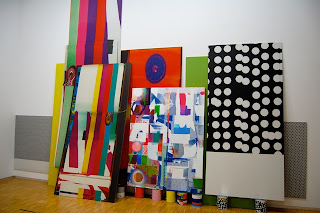On my free day in Paris, I chose to return to the Pompidou Centre to spend more time with the contemporary wing. I was previously unaware that New York contemporary artists Wade Guyton and Kelley Walker also functioned as a collaborative team. This did not surprise me, as they live and work in the same city, and their individual bodies of work are compatible in terms of process and content. The collaboration of well established artists is nothing new, Marina Abramovic and Uly, Björk and Matthew Barney, and aside from romantic collaborations, the Surrealists were notable for their collaborations.
An artistic partnership or collaboration inevitably calls in to questions ownership and authorship. It is difficult to ignore the individual contributions of those involved in collaboration. In the work present at the Pompidou Centre, Guyton/Walker takes on authorship head on. The work questions how two notably different aesthetic values can come together to form a completely separate entity. Guyton and Walker prefer to refer to their collaboration as third artistic identity, rather than a combination of artistic styles. Their collaborative works are even represented by a entirely separate gallery.
The work itself is several picture planes of black and white grids, distorted images of paint rollers, and strokes of color, leaning against the gallery wall, some balanced atop paint cans featuring similar imagery. Using a variety of screen printing and laser printing techniques, reproduction and repetition is driver for the content of this work.
 I spent a little longer with this work than some of the other works in the area, attempting to understand the intentions of the artists and pay attention to their formal decisions more closely. While analyzing their collaborative tactics, I was brought back to the essay written by Rosalind Krauss, The Originality of the Avant-Garde, which was assigned before coming to Paris. The written work first addresses the role of authorship in terms of Rodin’s sculptural work, which continued production even after Rodin’s death. The avant-garde perspective of originality and ownership is discussed in the section section of the essay. Krauss discusses the avant-garde’s focus on the basis of originality, their relationship to repetition and reproduction, and obsession with the grid.
I spent a little longer with this work than some of the other works in the area, attempting to understand the intentions of the artists and pay attention to their formal decisions more closely. While analyzing their collaborative tactics, I was brought back to the essay written by Rosalind Krauss, The Originality of the Avant-Garde, which was assigned before coming to Paris. The written work first addresses the role of authorship in terms of Rodin’s sculptural work, which continued production even after Rodin’s death. The avant-garde perspective of originality and ownership is discussed in the section section of the essay. Krauss discusses the avant-garde’s focus on the basis of originality, their relationship to repetition and reproduction, and obsession with the grid.
The grid was described as the ultimate form, void of author or originator, and high susceptible to appropriation. Guyton/Walker has appropriated this form in their work in the Pompidou on the panels to flanking both sides of the installation. Guyton/Walker also approaches ideals of the avant-garde in their use of appropriated imagery, and the printing processes used to produce the images.
Visual hierarchy is highly present in this work, as image planes fight for attention, jutting out from behind others, and struggling for height, standing on cans of paint. Imagery of paint rollers, sculptural paint cans, and painterly shapes created through a printing process brings in to question the studio practice, and begins to form a hierarchy of studio technique. This content present in a collaborative work complicates, as well as deepens, the self-reflexivity of a work challenging the notions of a studio practice. The work seems to ask itself, “Who is my owner? Where did I come from?” while visually drawing a viewer in through graphics and bright colors.
I am still researching the individual studio practices of Wade Guyton and Kelley Walker to get a better understand of how their collaborative work exists independently, but also how this collaboration relates to their separate bodies of work as an artistic endeavor.

No comments:
Post a Comment